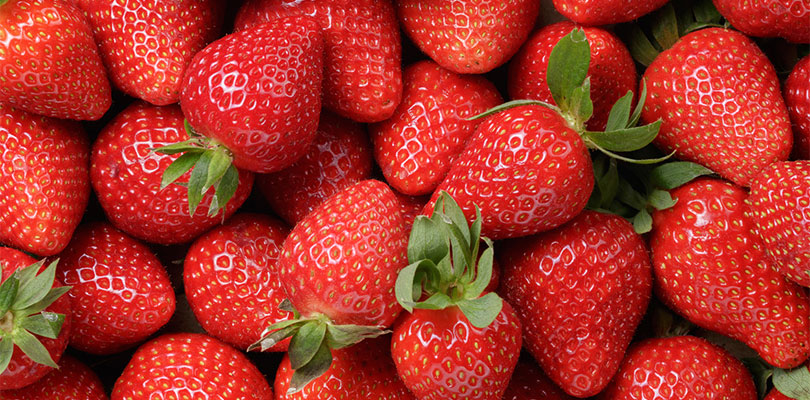11 foods to help whiten teeth naturally

Teeth staining can happen for several reasons, such as aging, poor eating habits, and an unhealthy lifestyle. To combat this, one could follow good oral hygiene, periodic dental cleaning, and professional tooth whitening to improve the color of the teeth. But apart from these measures, individuals could also make certain lifestyle choices, such as eating healthy foods. Below is a list of eleven foods that should be part of one’s meal regime for brighter teeth.
Strawberries
Eating strawberries could benefit one’s teeth, especially its color. The berry is rich in malic acid concentration, a property used in many toothpaste formulas. The acid works like a natural astringent and helps remove the tooth surface discoloration. One should note that strawberries are also abundant in citric acid, which may weaken the enamel. Therefore, each individual must wait at least 30 minutes to brush their teeth after consuming strawberries or other acidic foods. One could also rinse their mouth with water to negate the effects of citric acid after eating the berry.
Onions
Many are unaware of the health benefits associated with onions regarding oral hygiene. While the vegetable might cause bad breath, eating it in small amounts may benefit the teeth. The food contains antibacterial sulfur compounds that may prevent plaque from forming on the teeth. One could include onions on sandwiches and in salads when they can. Another food with similar sulfur compounds is garlic, which could prevent plaque and reduce the risk of yellowing teeth.
Apples
The fruit has several beneficial properties, including those associated with the teeth. Apples are crunchy. Therefore, its texture is a natural abrasive scrub, which helps clean the teeth when chewing on them. Furthermore, apples have a high malic acid concentration that could promote extra saliva and positively affect the teeth’ color.
Pineapple
The teeth are covered with a pellicle or a layer of salivary proteins. This layer protects the teeth and absorbs pigments from food, which could lead to staining. Furthermore, the pellicle layer also gives bacteria something to stick to, the accumulation of which may trigger plaque and tooth discoloration. Here’s where eating pineapple slices may naturally help the teeth. The fruit contains a proteolytic enzyme called bromelain. The enzymes are known to naturally break down proteins, including the pellicle layer, which could reduce the risk of tooth discoloration.
Cheese
Dairy products such as cheese are a top choice for maintaining healthy teeth and achieving a brighter smile. These foods are rich in calcium, protein, and phosphorus, all of which have properties that can help neutralize the acids in our mouth. Calcium and phosphorus also play a crucial role in repairing and remineralizing teeth. Consuming hard cheeses can act as a natural tooth scrub, removing plaque buildup. However, it’s important to opt for low-fat cheese to minimize the intake of unhealthy saturated fats, which can lead to heart complications.
Watermelon
Eating watermelon could introduce healthy amounts of malic acid to the body, promoting saliva production and lightening the teeth. Experts also indicate that the fruit’s fibrous texture scrubs the teeth and helps remove stains.
Milk
Another dairy product that could help naturally whiten the teeth is milk. Its lactic acid may lighten the enamel and stimulate saliva production, which could wash away cavity-causing bacteria. Casein, a protein in milk, prevents staining and attracts calcium phosphates to repair cavities and prevent plaque accumulation. Furthermore, studies indicate that casein binds to polyphenols in tea, which prevents tannins from sticking to teeth and causing staining.
Raw broccoli
Eating raw broccoli florets could have immense benefits for one’s teeth health. When the person chews the vegetables, their nutritional-rich texture works like a toothbrush and naturally cleans the teeth. Furthermore, broccoli is high in iron content that may coat the tooth enamel and keep harmful bacteria, stains, and acid erosion away. The food is also rich in other properties that could improve one’s health.
Papaya
Eating papayas could introduce papain, a proteolytic enzyme, to one’s mouth. The property helps break down protein, which degrades the pellicle layer. As a result, eating papaya may help reduce staining and protect the teeth against plaque formation.
Walnuts
Nuts like walnuts could work as teeth “exfoliants.” The food is naturally abrasive, which could help scrub plaque and other particles off the teeth to keep them white. One could also include other nuts like cashews and almonds to improve the quality of the teeth. Moreover, nuts could buff away discoloration to make the surface of the teeth appear whiter. Apart from nuts, one could also consume sunflower and sesame seeds, which have similar benefits in removing plaque from teeth. These seeds may also possess tooth-and-bone-strengthening calcium.
Orange peels
One should consider the peels of an orange to help whiten teeth naturally. While the fruit is acidic, the peel is less concentrated. The orange peel is also rich in vitamin C, a natural tooth-whitening element. One must wash the peel and rub the white inner part across the surface of the teeth to help minimize plaque and tackle tatar buildup. An individual must also speak to a healthcare expert before making any changes to their meal regime to improve the color of their teeth.



